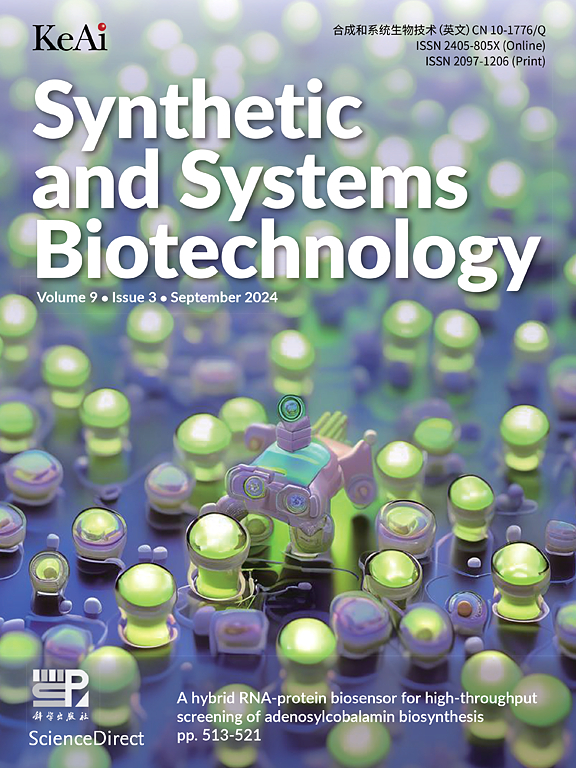ActinoMation:用于链霉菌属中通量机器人连接的识字编程方法
IF 4.4
2区 生物学
Q1 BIOTECHNOLOGY & APPLIED MICROBIOLOGY
引用次数: 0
摘要
链霉菌属是抗生素和其他重要的药用生物活性化合物的宝贵生产者。分子工程工具的进步,如CRISPR,已经为链霉菌的代谢潜力提供了一些途径,但菌株的有效基因工程受到费力和缓慢的人工转化协议的阻碍。在本文中,我们提出了一种半自动化的中通量工作流程,用于将重组DNA引入链霉菌(Streptomyces sp.),使用价格合理且开源的Opentrons (OT-2)机器人平台。为了增加工作流的可访问性,我们提供了一个开源协议创建者,actiomation。ActinoMation是一个在Jupyter Notebook中使用Python的识字编程环境。我们用pSETGUS和pIJ12551质粒转化了colcololstreptomyces (M1152和M1146)、S. albidoflavus (J1047)和S. venezuela (DSM40230),验证了该方法的有效性。我们证明了M1152与pSETGUS和pIJ12551的共轭效率为3.33∗10−3/ 0.33%;pSETGUS和pIJ12551在M1146中的表达率为2.96 * 10−3/ 0.29%;pSETGUS对J1047的假阳性率为1.21∗10−5/ 0.0012%,pIJ12551的假阳性率为4.70∗10−4/ 0.047%,pSETGUS对DSM40230的假阳性率为4.97∗10−2/ 4.97%,pIJ12551的假阳性率为6.13∗10−2/ 6.13%,假阳性率在8.33% ~ 54.54%之间。偶联工作流程的自动化有助于在更大范围内简化工作流程,而不会明显降低偶联效率。本文章由计算机程序翻译,如有差异,请以英文原文为准。

ActinoMation: A literate programming approach for medium-throughput robotic conjugation of Streptomyces spp
The genus Streptomyces are valuable producers of antibiotics and other pharmaceutically important bioactive compounds. Advances in molecular engineering tools, such as CRISPR, have provided some access to the metabolic potential of Streptomyces, but efficient genetic engineering of strains is hindered by laborious and slow manual transformation protocols. In this paper, we present a semi-automated medium-throughput workflow for the introduction of recombinant DNA into Streptomyces spp. using the affordable and open-sourced Opentrons (OT-2) robotics platform. To increase the accessibility of the workflow we provide an open-source protocol-creator, ActinoMation. ActinoMation is a literate programming environment using Python in Jupyter Notebook. We validated the method by transforming Streptomyces coelicolor (M1152 and M1146), S. albidoflavus (J1047), and S. venezuelae (DSM40230) with the plasmids pSETGUS and pIJ12551. We demonstrate conjugation efficiencies of 3.33∗10−3/0.33 % for M1152 with pSETGUS and pIJ12551; 2.96∗10−3/0.29 % for M1146 with pSETGUS and pIJ12551; 1.21∗10−5/0.0012 % for J1047 with pSETGUS and 4.70∗10−4/0.047 % with pIJ12551, and 4.97∗10−2/4.97 % for DSM40230 with pSETGUS and 6.13∗10−2/6.13 % with pIJ12551 with a false positive rate between 8.33 % and 54.54 %. Automation of the conjugation workflow facilitates a streamlined workflow on a larger scale without any evident loss of conjugation efficiency.
求助全文
通过发布文献求助,成功后即可免费获取论文全文。
去求助
来源期刊

Synthetic and Systems Biotechnology
BIOTECHNOLOGY & APPLIED MICROBIOLOGY-
CiteScore
6.90
自引率
12.50%
发文量
90
审稿时长
67 days
期刊介绍:
Synthetic and Systems Biotechnology aims to promote the communication of original research in synthetic and systems biology, with strong emphasis on applications towards biotechnology. This journal is a quarterly peer-reviewed journal led by Editor-in-Chief Lixin Zhang. The journal publishes high-quality research; focusing on integrative approaches to enable the understanding and design of biological systems, and research to develop the application of systems and synthetic biology to natural systems. This journal will publish Articles, Short notes, Methods, Mini Reviews, Commentary and Conference reviews.
 求助内容:
求助内容: 应助结果提醒方式:
应助结果提醒方式:


